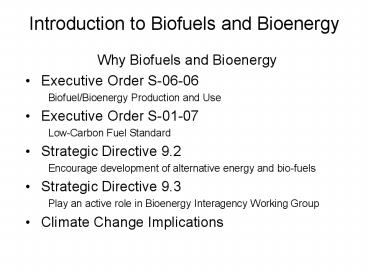Introduction to Biofuels and Bioenergy - PowerPoint PPT Presentation
1 / 18
Title:
Introduction to Biofuels and Bioenergy
Description:
Gross resources are 80 billion bone dry tons annually ... Second round of emissions testing to be validated by SCAQMD. Health risk assessment underway. ... – PowerPoint PPT presentation
Number of Views:4541
Avg rating:3.0/5.0
Title: Introduction to Biofuels and Bioenergy
1
Introduction to Biofuels and Bioenergy
- Why Biofuels and Bioenergy
- Executive Order S-06-06
- Biofuel/Bioenergy Production and Use
- Executive Order S-01-07
- Low-Carbon Fuel Standard
- Strategic Directive 9.2
- Encourage development of alternative energy and
bio-fuels - Strategic Directive 9.3
- Play an active role in Bioenergy Interagency
Working Group - Climate Change Implications
2
What Are Biofuels
- Biofuels
- Renewable fuels produced from biomass resources
to make liquid or gas fuel - Ethanol
- Biodiesel
- Compressed or Liquid Natural Gas
- Hydrogen
- Dimethyl Ether (diesel-like fuel
- Biobutanol
3
Feedstock for Biofuels and Bioenergy
- Forest and Agricultural Biomass
- Urban Biomass
- Biomass fraction of MSW
- Landfill Gas
4
Biomass Resources in California
- Gross resources are 80 billion bone dry tons
annually - Three principal resources are agriculture,
forestry, and waste - Forestry in northern and central mountains
- Agriculture in Central Valley
- Waste in Los Angeles and San Francisco Bay Area
Source California Biomass Collaborative
5
Waste Characterization in California
- 42 million tons disposed in 2005
- 23 million tons biological in origin
- 5.7 million tons plastic and textiles
6
Post-MRF Residuals
- Targeted Feedstock
- Single-Stream - 496,000 Tons
- Multi-Stream - 35,931 Tons
- Mixed Waste - 6.7 Million Tons
- Construction and Demolition - 161,736 Tons
7
Available Residuals Single Stream (496,000 Tons)
8
Available Residuals Multi Stream (35,931 Tons)
9
Available Residuals Mixed Waste (6.7 Million
Tons)
10
Available Residuals CD (161,736 Tons)
11
Biofuels/Bioenergy Production
- Thermochemical Processes
- Pyrolysis
- Very little air/oxygen added or none at all
- 750o F to 1500o F
- Gasification
- Some air/oxygen used but less than for
incineration - Begins at 1300o F
12
Biofuels/Bioenergy Production
- Biochemical Processes
- Anaerobic Digestion
- Bacteria breaks down feedstock
- No oxygen
- Fermentation
- Also anaerobic process
- Microbes used to produce ethanol
13
Major Technology Types and Status
14
Operating Facilities
- Biochemical
- Predominantly anaerobic digestion in Europe
- Installed capacity in 2000 1.1 million TPY
- Installed capacity in 2004 2.8 million TPY
- 250 increase!!!
- Thermal
- Gasification and Waste-to-Energy in Japan
15
AD Capacity in Europe
Solid Waste Anaerobic Digester Capacity in Europe
16
AD Facilities
- Kompogas (Switzerland)
- Arrow Bio (Israel)
- DRANCO (Belgium)
- Valorga (France)
- BTA (Germany)
- Biopercolat (Germany)
- CiTec (Finland)
- Linde-KCA (Germany)
17
Hydrolysis/Fermentation Facilities
- BlueFire Ethanol
- Masada Oxynol
- Genahol/Waste-to-Energy
- BRI
18
DOE cellulosic biorefinery commercialization
awards
- Abengoa Bioenergy Kansas
- Alico(BRI technology) - Florida
- BlueFire - California
- Broin South Dakota
- Iogen - Idaho
- Range Fuels - Georgia































